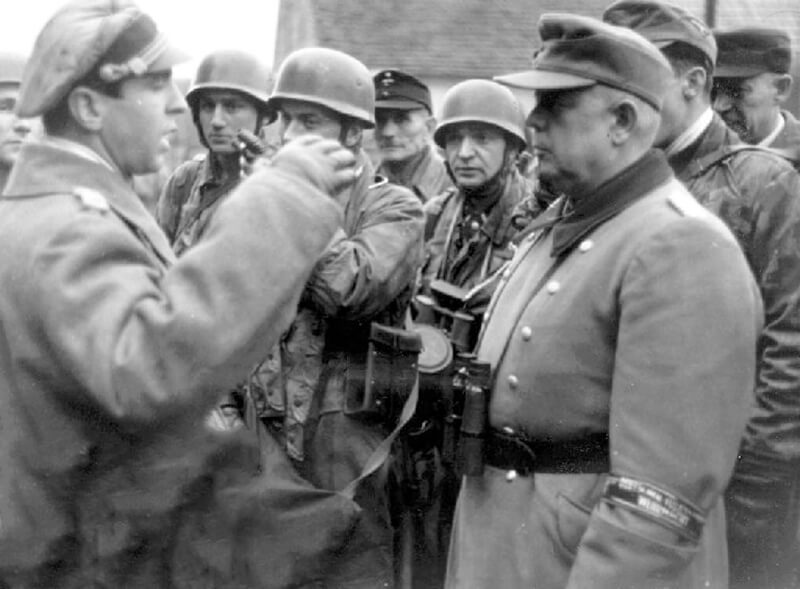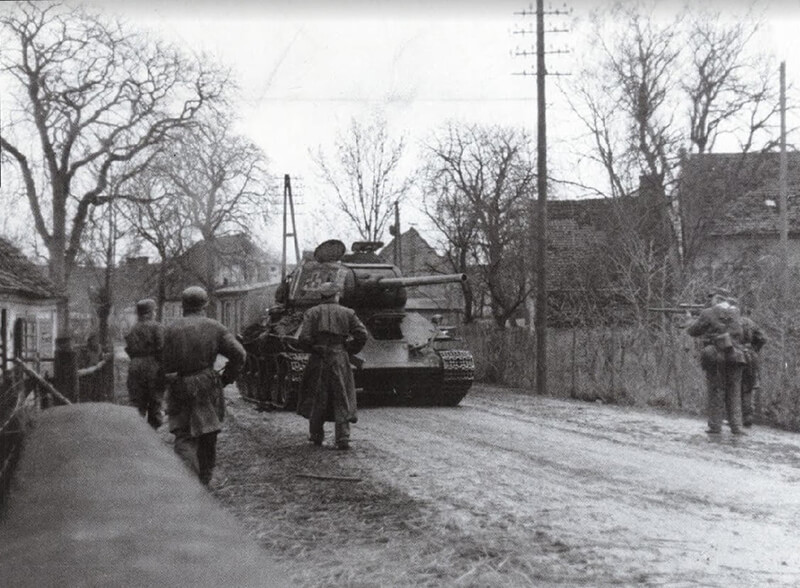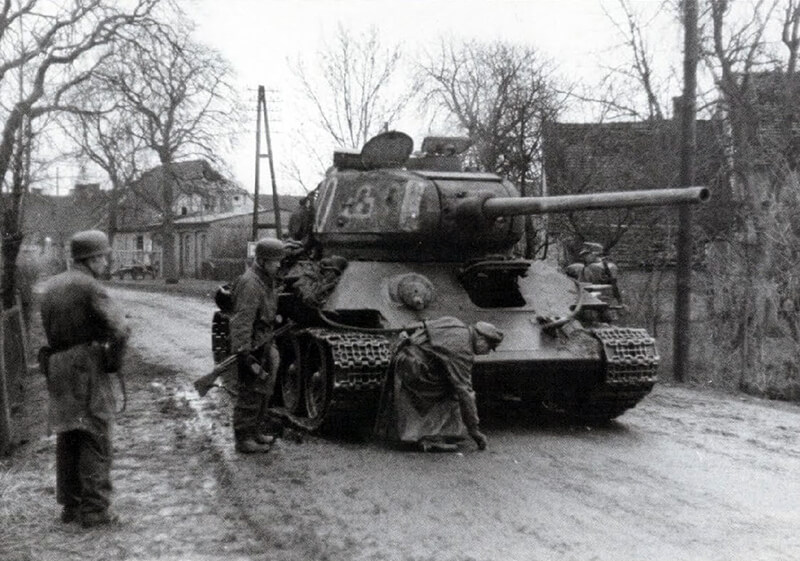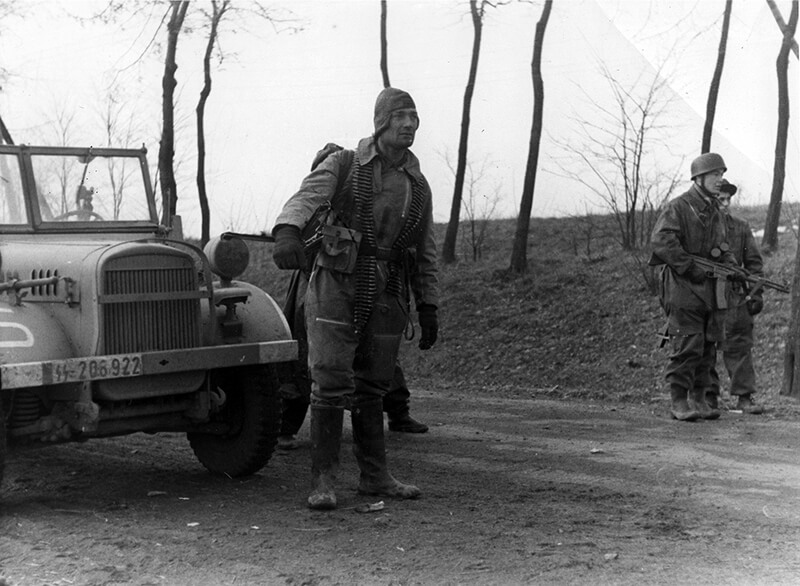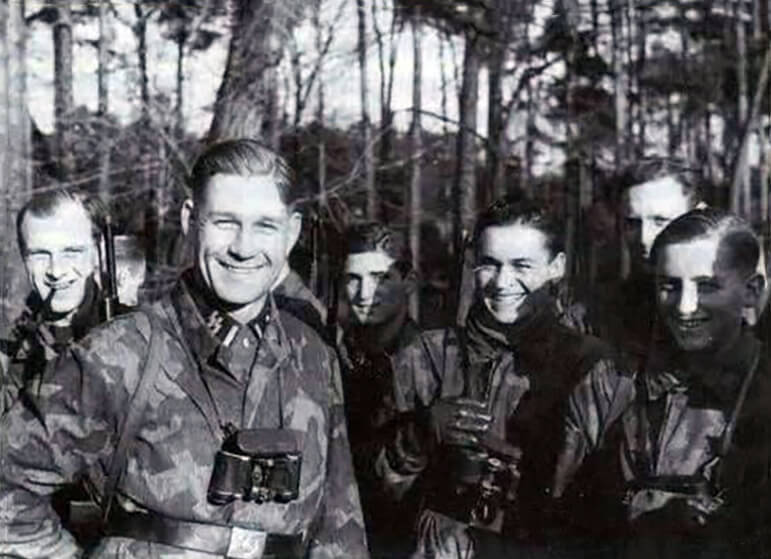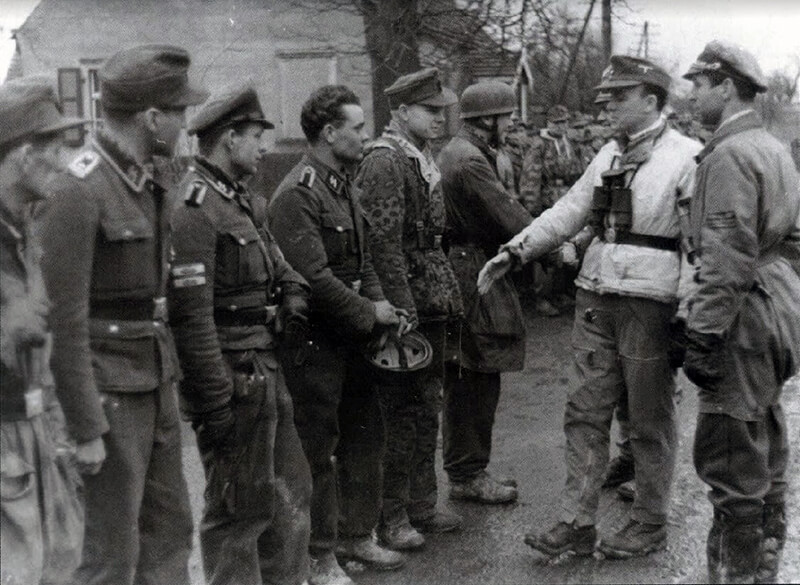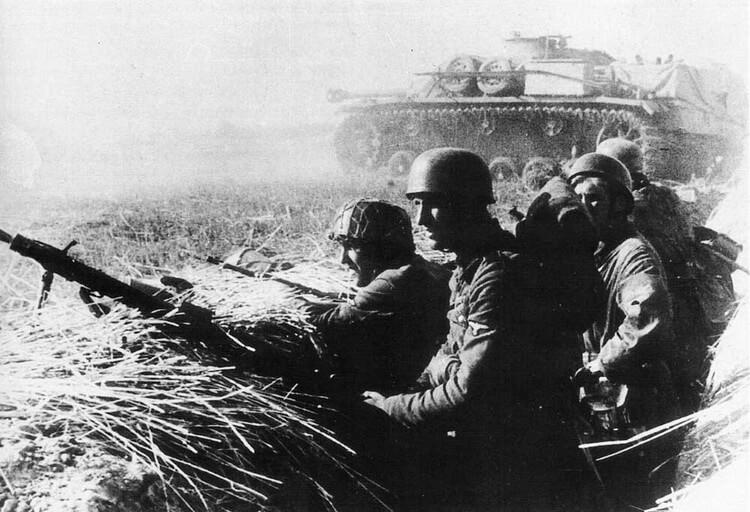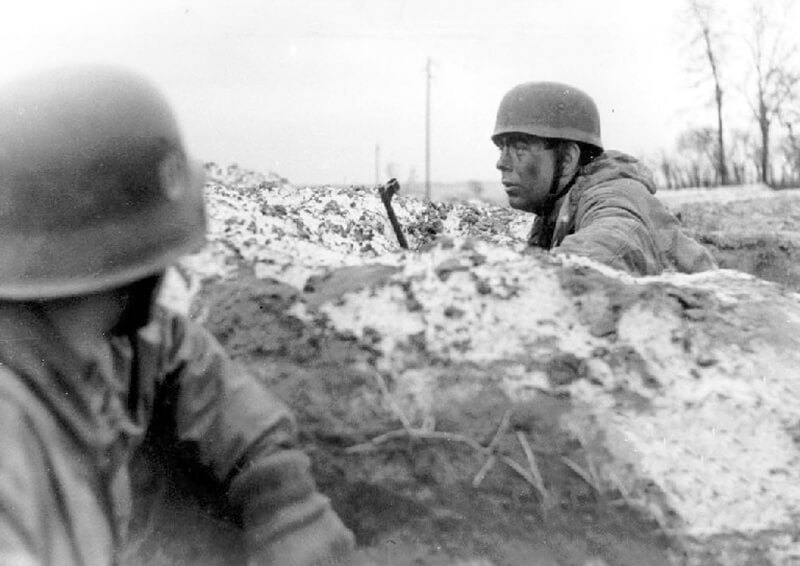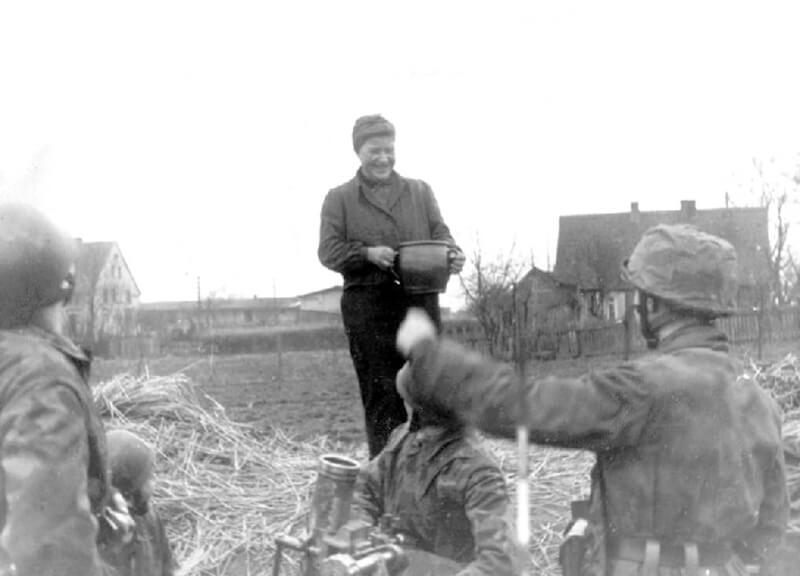| February 1st, 1945 – March 3rd, 1945 |
| Schwedt Bridgehead |
| Objectives |
- establish a bridgehead east of the Oder River near Schwedt, Germany, which will serve as a base for a subsequent offensive maneuvering.
- relieving the town of Freienwalde, Germany.
| Operational Area |
Schwedt area, Germany
| Unit Force |
Schwedt Division
- Stab Solar
- SS-Jagdverband-Nachrichten-Kompanie.
- SS-Jagdverband-Scharfschützer-Zug.
- SS-Jagdverband-schwere-Infanterie-Geschütze-Zug
- Auffangkompanie Weiss
- Versorgungs-Kompanie
- Kraftwagen-Werkstatt-Zug
- Sanitäts-Kompanie
- SS-Jagdverband Mitte
- Stabskompanie
- 1. Kompanie
- 2. Kompanie
- 3. Kompanie
- 4. Kompanie
- SS-Jagdverband Nordwest
- Stab und Stabskompanie
- SS-Jagdeinsatz Skandinavien
- SS-Jagdeinsatz Dänemark
- SS-Jagdeinsatz Niederlande
- SS-Jagdeinsatz Belgien
- SS-Fallschirmjäger-Batallion-600
- Stabs-Kompanie
- 7,5 cm Panzerabwehrkanone 40
- Sonderkraftfahrzeug 1
- StugIIIG
- 1. Fallschirm-Schützen-Kompanie
- 2. Fallschirm-Schützen-Kompanie
- 3. Fallschirm-Schützen-Kompanie
- 4. Fallschirm-(schwer-waffen)-Kompanie
- schwere SS Infanterie-Geschutze-Kompanie
- Stab
- 3 15 cm schweres Infanterie Geschütz 33
- 3 Sonderkraftfahrzeug 11
- Stabs-Kompanie
- Waffen Grenadier Regiment of the SS (1st Romanian)
- Stab
- Batallion
- Batallion
- Ersatz Batallion
- Stab
- Panzer-Grenadier-Ersatz-Bataillon 3
- Panzer-Grenadier-Ersatz-Bataillon 9
- Panzer-Grenadier-Ersatz-Bataillon 83
- Stray Batallion
- Stab
- 1. Kompanie
- 2. Kompanie
- 3. Kompanie
- Pionier-Ersatz-Bataillon 12
- Stab
- 1. Pionier Kompanie
- 2. Pionier Kompanie
- 3. Pionier Kompanie
- Volkssturm Batallion Königsberg
- Stab
- 1. Kompanie
- 2. Kompanie
- 3. Kompanie
- 4. Kompanie
- Volkssturm Batallion Hamburg
- Stab
- 1. Kompanie
- 2. Kompanie
- 3. Kompanie
- 4. Kompanie
- Artillerie Batallion, 27. Flak-division
- Stab
- Flak Batterie
- Flak Batterie
- Flak Batterie
- Flak-Ersatz-Abteilung 12
- Sturmgeschütz-Brigade 210
- 1. Batterie
- 2. Batterie
- 3. Batterie
- Fallschirm-Panzer-Jagd-Bataillons 54
- Stab
- 1. Kompanie
- 2. Kompanie
- 3. Kompanie
- 4. Kompanie
- 5. Kompanie
- 6. Kompanie
- Fliegerregiment 53
- Stab
- I. Bataillon
- 2. Bataillon
- Ost Truppen-Regiment 122
- Stab
- 5. (Ost-) Nachschub-Batallion
- 6. (Ost-)/Nachschub-Batallion
- Volks-Grenadier-Regiment 1091
- 1. Batallion
- 2. Batallion
| Opposing Forces |
1st Belorussian Front
- 61st Army
- 1st Polish Army
- 47th Army
- 3rd Shock Army
- 5th Shock Army
- 8th Guards Army
- 69th Army
- 33rd Army
- 16th Air Army
- 18th Air Army
- 1st Guards Tank Army
- 2nd Guards Tank Army
- 3rd Army
- 4th Artillery Corps
2nd Belorussian Front
- 2nd Shock Army
- 19th Army
- 49th Army
- 50th Army
- 65th Army
- 70th Army
- 5th Guards Tank Army
- 4th Air Army
| Operation |
| January 30th, 1945 |
During the afternoon, Skorzeny receives a telephone call from Himmler’s headquarters. Himmler had recently been appointed as the commander of Army Group Vistula. By Order 831, Skorzeny is instructed that his SS-Jagdverbände, along with all available units, should depart that very same day and head straight to Schwedt, Germany on the Oder.
The objective of this bridgehead is to serve as a secondary launching point for a German flank offensive towards the south. The Oberkommando der Heeres, led by Generaloberst Heinz Guderian, has devised a strategy for another assault originating from the Glogau an der Oder area. According to this plan, the German attacking forces are supposed to converge at Posen, with the intention of encircling the armies of the Soviet 1st Belorussian Front under the command of Marshal Georgi K. Zhukov. Simultaneously, they aim to eliminate the Soviet bridgeheads on the west bank of the Oder near Kienitz and Reitwein from a position behind enemy lines. This potential threat was looming in mid-February 1945.
Besides that, Skorzeny is also tasked with relieving the town of Freienwalde in Germany which has fallen into Soviet hands. Skorzeny and his staff can’t help but wonder how his forces can relieve a town “in passing,” so to speak.
Without delay, He issues the necessary orders to SS-Jagdverband Mitte under command of SS-Hauptsturmführer Fucker and SS-Fallschirm-Fallschirmjäger-Batallion 600 under command of SS-Hauptsturmführer Milius stationed in Neustrelitz, and the understaffed SS-Jagdverband Nordwest, comprising of only one company, also known as Kampfgruppe, under command of SS-Hauptsturmführer Hoyer. By that time, it is already 17:00, and Skorzeny schedules a meeting with his battalion commanders for 23:00.
The matter of transportation poses a significant concern, yet all the transport officers are put to work. The nearby depot willingly offers their assistance, committing to work tirelessly throughout the night and contribute their own vehicles.
Together with his newly appointed Operations officer, Captain Hunke, Skorzeny and his staff diligently prepare the orders for reconnaissance and the subsequent march. Through careful calculations, they determined that, if all proceeded as planned, the men could leave by 05:00.
| January 31st, 1945 |
Skorzeny and his staff arrive in Schwedt shortly before 08:00. Here the awaiting reconnaissance parties congregate near the Oder Bridge. Their primary objective is to conduct thorough reconnaissance as far as Königsberg in the Neumark, providing Skorzeny with essential knowledge of the terrain ahead of our intended bridgehead. After this briefing, Skorzeny seeks out the commandant of Schwedt. Communications with Army Group swiftly clarifies the command structure within the town. It becomes apparent that the colonel, along with a small staff, is required elsewhere and will depart on February 1st, 1945.
In addition to assuming command in Schwedt, three depot battalions and a pioneer battalion are added to Skorzeny’s command. However, these units primarily consist of elderly and infirm soldiers.
However, before the arrival of the battalions, Skorzeny finds it essential to thoroughly examine the bridgehead. The bridge itself, stretching nearly a kilometer, spans both the river and the Oder Canal. In between lay flooded meadows, connected by a causeway. Although the river is frozen, its icy surface poses a worrisome threat in case of a Russian arrival. To address this concern, the pioneer battalion’s primary task will be to demolish the ice. Additionally, we could request icebreakers from Stettin to assist us. Furthermore, if we could successfully manipulate the sluices and flood the area between the river and the canal, we would establish a formidable barrier against any surprise Russian assaults across the river.
An efficient gathering point is needed to collect all the stragglers who were currently wandering aimlessly. These individuals will then be utilised to transform the depot battalions into combat-ready formations.
Later in the afternoon, Skorzeny holds an extensive discussion with the major of Pionier-Ersatz-Bataillon 12. Together, they sketch the boundaries of the intended bridgehead on the map, ensuring a radius of six kilometres that follows the natural contours of the hilly terrain, which will prove advantageous for the defence of the bridgehead. They devised an outer defensive ring, and once that is in place, a smaller inner ring.
The outer perimeter of the bridgehead intends to span eighteen kilometres. The border line has the following configuration: it begins just south of Lower Saathen and immediately enters mountainous terrain. Outposts are designated for Oder-Randdorf Raduhn and Vorwerk Elisenhöhe. From there, the trench is planned to extend to height 63, located two kilometers from the village of Hanseberg. Notably, Hanseberg, along with Amalienhof farm, remains outside the front lines of the bridgehead. The capture of Hanseberg is considered crucial. The village is constantly under threat from the Soviet-occupied Peetzig Forest, making it vulnerable in both the flank and rear. The primary battle line is intended to run from height 63, extending one kilometre southeast past Grabow, through the Dorst area, and then to the forest-meadow edge of the Röhrike River, opposite the Nahausener Mühle. From this point, it will continue to the mouth of the Röhrike River, leading into the East Oder.
The labour battalion and the male population from the town and its immediate vicinity are drafted to provide manpower. With an abundance of country carts available, and under the skilled direction and supervision of Pionier-Ersatz-Bataillon 12, they make good progress. Simultaneously, Skorzeny dispatches the SS-Jagdverband Nordwest and SS-FallschirmJäger-Battalion 600 under command of SS-Hauptsturmführer Siegfried Milius to secure a position east of Königsberg, ready to engage in a delaying action if necessary. The Königsberg militia battalion, led by its NSDAP commander, is placed in a supporting role. Finally, SS-Jagdverband Mitte assumes positions along the inner defensive line, prepared to defend the reduced bridgehead at any cost in the event that the Russians manage to breach the defenses through surprise tactics.
SS-Hauptsturmführer Siegfried Milius, the commanding officer of SS-Fallschirmjäger-Battalion 600, is the leader on the battlefield, supported by his exceptional company commanders as Macki Markus, Walter Scheu, Werner Dröste, and Fritz Leifheit.
| February 1st, 1945 |
The conducted reconnaissance to determine the enemy’s location and potential avenues of attack, deliver their first reports. Russian troop movements are reported near and south of Bad Schönfliess, Germany. However, their patrols are small, and when engaged in combat, the Germans emerge victorious with minimal casualties.
In the ensuing days, a feverish atmosphere envelope as everyone works hard to fortify the field works. Within a few days, they are ready to commence construction of the inner defensive line, with the soldiers taking charge of the finishing touches. Through the mayor, Skorzeny advises the civilian population of Königsberg to evacuate the town, ensuring their safety by arranging accommodations in Schwedt.
Unexpectedly, a militia battalion from Hamburg arrives in Königsberg. The majority of these men are robust and brimming with enthusiasm. The weapons and equipment provided by the Hamburg battalion are of excellent quality, a testament to the efforts of Defence Commissioner Kaufmann in that city. However, the Königsberg Batallion faces more challenges in terms of resources.
| February 2nd, 1945 |
The conclusion of the reconnaissance of the bridgehead is that there are no Wehrmacht units deployed north and south of Schwedt/Oder on February 1st, 1945, and there is no German military in Nipperwiese either.
The fishing village of Nipperwiese is, so to speak, cut off from the five-village bridgehead. Since there is no stable front line to Fiddichow, five kilometres away, it is completely isolated: to the north there is a two-kilometer-wide strip of forest, controlled by the Soviet Army; in the south the Röhrike river with its flooded, frozen meadows; in the back is the East Oder and the three-kilometre wide flooded Schwedter Polder.
Although the town’s defenders have no tanks or artillery, this village is to be held at all costs.
The cause of this highly sensitive vigilance are the two dikes on the Schwedt/Oder – Nipperwiese crossing, i.e. the waterway that connects the West-Oder with the East-Oder. It dawns on the top Wehrmacht leadership at an early stage that the local Soviet Army commanders expresses interest in the Schwedt bridge dam, but in the event that both rivers on the Oder are forced, they will certainly shortlist the dykes of the crossroads in order to fight for them as an advance passage and immediately afterwards as a transport route for tanks, self-propelled guns and artillery. The dikes are about five metres high and four metres wide at the top.
| February 3rd, 1945 |
The force successfully stations a fully equipped battalion on each flank. Anticipating the main attack to originate from the direction of Königsberg, the two central sectors for Skorzeny’s battalions.
A Luftwaffe Oberstleutnant joins Kampfgruppe Schwedt with orders to assemble a battle unit comprising stray airmen. Within a week, he manages to organise three companies, along with valuable equipment sourced from Luftwaffe stocks. This addition proves significant as it enhances the intelligence capabilities in the sector, enabling the force to provide reliable updates on enemy movements.
However, instead of the requested artillery, Kampfgruppe Schwedt receives three anti-aircraft sections from Armee Gruppe most likely from the 27. Flak-division. The mobile batteries are transformed into field artillery and assigned battle stations within the bridgehead. The remaining batteries are positioned on the western bank of the Oder, functioning as heavy artillery. Kampfgruppe Schwedt benefits from the arrival of a talented artillery officer dispatched by Armee Gruppe, who works wonders in just a few days.
A General, most probably General der Infanterie Otto Lasch from Wehrkreis I informs Skorzeny and his staff that 1. Marine-Infanterie-Division has been integrated into the defense line on the western bank of the Oder, to the south of our position. Consequently, the Kampfgruppe is converted to the Schwedt Division, and both divisions are to form part of his new corps. The general expresses his approval of the orders implemented thus far and instructs us to continue our operations as before. The only directive he provides is to define the divisional boundaries. He expresses to be satisfied with the security measures taken in the Division Schwedt sector.
Skorzeny also receives an urgent and classified order from Führerhauptquartiere. It reveals that two trucks loaded with highly important state documents have been mistakenly abandoned in a forest east of Bad Schönfliess. Under no circumstances are these documents to fall into enemy hands. Although aircraft have been dispatched to destroy the trucks, they fail to locate them. It was the utmost priority for the Schwedt Division to regain possession of the forest, retrieve the documents, or ensure their destruction. The urgency of the task could not be overstated.
They find out that the documents in question are not vital state papers but rather party documents originating from Bormann’s office within the Nationalsozialistische Deutsche Arbeiterpartei. Therefore, Skorzeny insists that the official in possession of precise knowledge of their whereabouts to accompany his force. However, it is essential to conduct a thorough reconnaissance to evaluate the feasibility of a successful attack. Skorzeny, his dog and four trusted men, embark on foot towards the town of Bad Schönfliess.
At the town they are informed that Soviet troops have occupied the town for the past two days. Their headquarters, along with several tanks, are stationed at the railway station. Moreover, they have managed to restore the railway’s functionality, resulting in a continuous influx of troops and supplies. Upon receiving the report, Skorzeny makes the decision to verify its accuracy firsthand. Three of his men are assigned with the task of attempting to stealthily reach the station through the town, while another group approaches it from the road leading to the town gates. Upon their return, they convey that they have observed at least fifty tanks stationed near the railway station, with Russian troops encamping to the south and east of the town.
With this knowledge, it becomes evident that any endeavor to reach the forest and the two trucks amidst the presence of Russian forces will be futile. Skorzeny is confident that the Russians have already discovered the trucks themselves.
During their stay in the town, two young women choose to join the scouting party. The party allows them to sit on the floor of one of the scout-cars as they retreat.
Skorzeny issues orders for two reduced paratrooper platoons, consisting of fifty men, to move to the village of Bernickow. Their mission is to conduct reconnaissance and gather information on the movements of the leading Soviet units. However, in terms of their weaponry and equipment, they are not well-equipped for combat, resembling more of a security detail than a combat force, situated about one and a half kilometres from the city of Königsberg/Neumark.
These are the primary units of the Soviet 2nd Guards Army that arrive in the vicinity of Königsberg/Neumark. That very evening, the Russians launch an attack on Königsberg, employing approximately forty tanks and multiple battalions. Initially, the men of SS-Fallschirmjäger-Batallion-600 are caught off guard and find themselves in combat, particularly with Soviet tanks. It is reported that they manage to destroy eleven T-34 tanks before retreating to the city wall successfully repelling the initial assault, albeit sustaining significant casualties. However, around midnight, the enemy manages to breach the town’s defenses from the north and south. Intense house-to-house combat ensues.
| February 4th, 1945 |
During the night Skorzeny’s troops gradually yield ground, but by daybreak, they disengage and retreat into the bridgehead.
The Volksturm commander who also holds the position of the local Gauleiter in Königsberg is conspicuously absent during the battle for Königsberg itself. He only appears before SS-Hauptsturmführer Siegfried Milius afterwards. Milius, upon hearing his justifications, orders his execution for cowardice.
Skorzeny however claims that after returning to Schwedt he finds the commander of the Königsberg militia battalion. Skorzeny claims he orders his arrest for abandoning his troops and orders him to death.
Interviews with Siegfried Milius after the war and other sources indicate however that it is very likely that, contrary to widespread belief, that Skorzeny was not involved in this incident.
SS-Untersturmführer and Kompanieführer Dräger of 1. Kompanie, SS-Fallschirmjäger-Battailon 600, receives an order from Skorzeny. His orders are to dispatch patrols for reconnaissance towards the southeast. Dräger’s journey leads him to Königsberg-Neumarkt, where he joins forces with SS-Obersturmführer Markus. Together, they coordinate efforts to hold the town, with 3. Kompanie, SS-Fallschirmjäger-Battailon 600, playing a key role in the defensive strategy.
During the morning the Soviet 1st Mechanised Corps, to which the 49th Tank Brigade is subordinate, receives a fresh combat mission. Thanks to the protection provided by the 19th Mechanized Brigade from the north, the primary forces are redirected southwestward with the aim of capturing Königsberg. Krivoshein makes the decision to seize the city during the evening, anticipating simultaneous attacks from both the front and the flanks. According to the commander’s strategy, the 219th Tank Brigade will initiate the northern attack, bolstered by mechanised infantry. Units from the 49th Tank Brigade, along with detachments from the 35th Mechanised Brigade, will strike from the southeast. Simultaneously, the 37th Mechanised Brigade will launch an assault from the southwest.
Soviet units have already advanced over the railway track, effectively interrupting it as they work on establishing the Kienitzer bridgehead. This initially prevents the transport train, with the Hamburg Volkssturm battalion from reaching its destination, at the Königsberg/Neumark train station. This arrival takes place in the morning. During this time, the battalion’s commander engages in discussions about the food supplies for his troops with the master butcher, Kastner. Additionally, he orders three hundred loaves of bread for the next day. The commander emphasises the importance of defending the city in his discussions.
In the afternoon, around 16:00, seven Soviet tanks approach from the Uchtdorf direction, descending downhill in the snowy terrain towards the outskirts of Königsberg. The Hamburg Volkssturm units mobilises quickly, occupying parts of the railway embankment and engaging in combat, including using rocket-propelled grenades. The Volkssturm fighters are essentially drawn into the battle at Königsberg train station, become directly involved.
As soon as darkness falls, the Soviet offensive is set into motion. The units from the 49th Tank Brigade make swift progress into the town of Königsberg. Major Kulbyakin operates on the Königsberg’s main streets, closely coordinating with motorised riflemen under Major Turovts’ command. Meanwhile, tank units from the battalions led by Major Pavlov and Zhegalov push forward on adjacent streets. The effective mutual fire support between these brigades allows tank crews and mechanised infantry to overcome enemy resistance, methodically clearing building after building and steadily advancing towards the innercity.
| February 5th, 1945 |
Soldiers from the 49th Tank Brigade find themselves commencing battles after nightfall. By morning, the Germans are completely expelled from the city. Without pausing, the units press on with their offensive towards the Oder River, ultimately capturing the airfield. This airfield is immediately utilised by the Soviet Airforce. Even though the front line is situated only 6-10 kilometres away, pilots from the 3rd Fighter Corps, commanded by Lieutenant General Sawicki, successfully land at the airfield. The Germans attempt to obstruct the use of the airfield by shelling landing aircraft with anti-aircraft guns. The incoming aircraft are reported by an observer in the church tower of Hohenkronig. The Germans report to be quite effective in crashing Soviet aircraft this way. The Soviets report the Germans fail in doing so. Menawhile Soviet Army Command assigns special units to protect the airfield. The relocation of fighter aircraft to this permanent airfield proves instrumental for the Soviet front-line aviation gaining the upper hand in the Oder region. Consequently, the situation in the skies undergoes a transformation in Soviet favour, greatly aiding the Soviet ground forces, particularly the tank units, in their combat operations.
After the city of Königsberg is secured, elements of the 1st Mechanized Corps occupy the hills southeast of the populated areas, specifically Nipperwiese, Niederkranig, Grabow, and Raduhn. In the event that the advance encounters setbacks, the Germans had deployed fresh reserves and successfully halted our units’ offensive progress along the established defensive line. The 49th Tank Brigade was subsequently assigned the mission of commencing a march towards Schwedt and securing a bridgehead across the Oder River.
Initially, their actions seem to lack any tactical intention because they can’t take up prepared positions like trenches or individual foxholes. Instead, they seek cover and protection within the buildings on the outskirts of the city.
The fighting persists throughout the night and includes conflicts within the city itself. These are intense battles that resemble a sustained resistance. Eventually, Soviet units manage to break the resistance.
During the night the German forces retreat to the five-village bridgehead. Around fifty German soldiers, mainly from the Hamburg Volkssturm, are reported to have died in Königsberg during these battles.
As the nighttime evacuation begins, the Volkssturm fighters from Hamburg also make their way to the five-village bridgehead. A bit later, they position themselves along the West Oder between Schwedt and Lunow. Following the withdrawal from Königsberg, Otto Skorzeny sends a rapid and confidential command report via telegram at 00:30 stating: “Tomorrow (i.e., February 6th), the defence of Königsberg will be reinforced.”
As the bridgehead starts to collapse the Soviet divisional commander orders the use of three T-34 tanks to forcibly clear the Schwedter Oder crossing just before sunrise. Guard Lieutenant Oleg Matveyev, a resourceful reconnaissance officer, is given this task. He leads a platoon in the tank company commanded by Guards Lieutenant Achot Amatun.
Matveyev’s tank rushes into Niederkränig, with the other T-34s providing temporary fire cover in front of the village. Matveyev’s tank advances toward the East Oder Bridge, reporting that the bridge entrance is closed and the area is flooded. However, his tank is ultimately destroyed by a Panzerfaust rifleman. The daily report from the 2nd Guards Tank Armed Forces confirms the tragic death of Guards Lieutenant Oleg Matveyev and his loader Sharkow, while the injured driver Telkow manages to reach the Soviet lines.
By this time, the Soviet Army and Polish Armies have significantly expanded their forces, rendering German reconnaissance operations behind enemy lines impractical. With the capture of the railway in Bad Schönfliess by the 2nd Belorussian Front, a continuous influx of reinforcements reaches them by train. Unbeknownst to Skorzeny, these reinforcements belong to the 61st Army and the 1st Polish Army of the 1st Belorussian Front’s northern flank. Their orders are to bypass Schwedt and launch an attack towards Eberswalde. This manoeuvre also conceals the movement of the 2nd Belorussian Front’s 49th Army, which is set to attack the north of Schwedt.
A combination of elaborate deception operations and rapid advances contributes to the German command’s limited awareness of the forces’ shift and the true direction of the impending offensives.
Meanwhile, Skorzeny receives some temporary reinforcements in the form of Fallschirm-Panzerjagd-Bataillon 54. The battalion’s numerical designation, Fallsch.Pz.Jg.Btl. 54, is derived from the name of the tank launching device they use, known as the “Panzerschrei” or “Ofenrohr.” This device is called the “Panzerbüchse 54” or “Rocket Panzerbüchse 5.” It is a tube that measures 164 centimetres in length and fires a three-kilogram grenade. The effective firing range for this device is up to 130 metres. The unit consists of six companies. The unit is hastily formed from obsolete Luftwaffe personnel and lacks the typical Fallschirmjäger uniforms and Fallschirmschützenbluse. The unit expects to receive this equipment in the Schwedt barracks. However, the Schwedt barracks is also not equipped with these uniform pieces.
| February 6th, 1945 |
The five-village bridgehead is nearly completely overrun, except for the Oder-edge village of Niederkränig.
In light of these losses and the challenging situation, the Soviet commander decides to abandon the idea of quickly establishing a bridgehead to the left or right of Schwedt. This option is deemed too costly in terms of human lives and potential failure.
Additionally, fifty German assault guns and armored personnel carriers arrived in Schwedt/Oder to bolster the defensive efforts.
| February 7th, 1945 |
During the night, Skorzeny deploys mounted infantry on the bridge embankment in front of Niederkränig. The attacking force consists of approximately one regiment, totaling around a thousand men. Among them are the men of Fallschirm-Panzerjagd-Bataillon 54. At their position along the West Oder, Schwedt and Lunow the Volkssturm Hamburg is down to 26 officers, 139 non-commissioned officers and 392 enlisted men.
During the morning, Skorzeny issues the order to counterattack with the aim of restoring the previous situation in the five-village bridgehead and expanding it. The assault is supported by two batteries from Assault Gun Brigade 210, including the 3. Batterie led by Hauptman Vincon with eight assault guns and the 2. Batterie led by Leutnant Schmeing-Engberding with nine combat vehicles. The primary objective is to launch an attack on the city of Königsberg/Neumark, approaching it via two wedges through Grabow and Hanseberg.
Given that the meadow lowlands on both sides of the Röhrike river are still flooded and iced over, the plan is to advance south of Königsberg/Neumark, crossing the airfield site, and then move north along the Königsberg/Neumark – Stettin railway line and the Bernickow road towards Thänsdorf in the northeast direction to initiate the attack. The recapture of Königsberg/Neumark and the airfield is of utmost importance as Skorzeny has orders to establish an operational bridgehead. This bridgehead is to cover an extensive area, stretching at least thirty kilometres from Fiddichow to Zehden, with a depth of twenty kilometres from the Oder to the railway line, and extending forty kilometres in each direction towards Soldin and Neudamm.
Crucially, the attack on the city and Königsberg/Neumark airfield needs to occur outside the range of Soviet artillery. Both Colonel-General Bogdanov, the head of the 2nd Guards Tank Army, and Colonel-General Pavel A. Belov, the head of the 61st Army, anticipates this strategy.
For the assault the Schwedt Division mobilises all available troops and armoured vehicle. As they advance, they traverse the village of Grabow, which has already seen significant destruction following the evacuation of the five-village bridgehead due to heavy fighting.
Continuing on, they approach Hanseberg, with hatches closed and machine guns on top of the assault guns manned from within. The terrain is challenging, with muddy and slippery conditions, but the columns press forward.
Suddenly, a T-34 tank appears amidst the trees, one of the assault guns targets it. After a brief exchange, the assault gun manages to destroy the T-34 with a shot, averting a potentially dire situation. Another T-34 spotted near a stable does not respond to ther attack, leading to speculation that it might have been unmanned.
Upon reaching the outskirts of Hanseberg, infantry dismounts the combat vehicles and prepares to participate in infantry combat. As they approach the village street, they engage in fierce fighting, shooting at buildings and suspected Red Army positions.
The battle in Hanseberg intensifies, with the sound of assault guns and T-34 tanks, along with the rapid firing of machine guns. The infantry eventually secures the village street, which leads past the manor castle, church, and cemetery, all enclosed by a high wall.
The situation grows more intense as the infantry encounters a T-34 tank, which is promptly destroyed by one of the assault guns. Continuing through Hanseberg, they find some buildings on fire and evidence of tank shell damage, but the civilian population has seemingly evacuated before.
As evening approaches, the assault guns leave the village, and the infantry unit is ordered to secure vulnerable points against potential enemy surprises.
Following engagements to the north of their position, the 9. Armee, taking over from the 3. Panzer-Armee, is compelled to retreat from its advanced defensive positions.
Subsequently, the evacuation of all villages located beyond the bridgehead is initiated. Concurrently, two battalions from the Red Army, backed by T-34 tanks, carry out daily reconnaissance missions during the ongoing evacuation process.
| February 8th, 1945 |
Skorzeny actively participates in an assault on Soviet artillery batteries located in Johannisgrund. He leads a detachment of SS-Jagdverband Mitte, collaborating with members of 2. Kompanie, SS-Fallschirmjäger-Battailon 600. The outcome of this engagement favours the German forces, resulting in victory.
During the morning Fallschirm-Panzer-Jagd-Bataillon 54 retreats from the bridgehead and heads for the Weichsel Bridgehead.
| February 9th, 1945 |
The Soviets launch their armoured offensive. By that time, the command of 1. Kompanie, SS-Fallschirmjäger-Battailon 600, has passed to SS-Obersturmführer Walter Scheu. Positioned ahead of Grabow on the road leading to Schwedt, approximately 2.5 kilometres west of Königsberg, the unit takes defensive positions. With the assistance of Volksturm forces, they dig in to face the oncoming threat.
This battle sees Scheu’s men engaging fiercely with Soviet forces, resulting in the destruction of numerous enemy tanks. 1. Kompanie, SS-Fallschirmjäger-Battailon 600 under Scheu also defends the road in front of Grabow, they reportedly destroy a total of seventeen Soviet tanks in one morning. These tanks were advancing from the direction of Königsberg.
The credit for the Battle of Königsberg must be attributed to the bravery and leadership of Walter Scheu and the valiant soldiers under his command.
Scheu is awarded with the Iron Cross 1st Class for his role in the Battle of Königsberg. Scheu’s contribution is notable, he also should have earned multiple Tank Destruction Badges which, regrettably, were never awarded. Later Scheu assumes command of 4. Kompanie, SS-Fallschirmjäger-Battailon 600, due to the virtual dissolution of the 1. Kompanie during the battle for Königsberg and the subsequent withdrawal.
Historical accounts of the time do not mention Skorzeny’s presence in Königsberg, whether during the arrival of 1. Kompanie, SS-Fallschirmjäger-Battailon 600, or the intense battle that follows.
At that moment Skorzeny has joined forces with a platoon from 3. Kompanie, SS-Fallschirmjäger-Battailon 600, under the leadership of Markus. This joint unit embarks on a reconnaissance patrol to Bad Schönflies. During this operation, Skorzeny guides the patrol as they encounter Soviet tank crews, many of whom, as per reports, are under the influence of alcohol. The patrol engages in an attack against the Soviet tank crews. However, the Soviets counterattack but suffer a significant number of casualties inflicted by German small-arms fire. Subsequently, the patrol withdrew from the situation.
During the following days, the battle goes back and forth, marked by relentless attacks and counterattacks that occur day after day. The German perform heroic acts against the Soviet overwhelming force. When two Soviet tanks manage to approach the bridge within a few hundred metres they are neutralised before reaching their target. The infantry that follows is repelled, largely due to the valiant efforts of the sharpshooter platoon. On another occasion, two enemy tanks approach Schwedt Castle, but they are stopped by the commander of that sector using a Panzerschreck.
During the course of the battle, the Fallschirmjäger Kompanie under command of Markus holding the crucial position at Nipperwiese is forced to retreat. This development is mentioned in Skorzeny’s evening report to the Corps.
Again, there is a big controversy here since Siegfried Milius declares after the war that Skorzeny insisted on the execution of Markus, due to his defiance of orders. Markus had chosen to withdraw his surviving company members from the battle after they had exhausted their ammunition and could not effectively combat the Soviet armor. Skorzeny staunchly adhered to Hitler’s directives against retreat. Most historical records indicate that Markus was indeed executed, although a few veterans claim he was spared, suggesting that Milius intervened on his behalf.
Skorzeny claims a wireless message arrives that day from the Corps headquarters inquiring whether the commanding officer at Nipperwiese had already faced court-martial or execution. Skorzeny claims that he informs Corps headquarters that the officer in question is not executed and would not be subjected to a court-martial. He claims that he moved on to Grabow in the bridgehead to join the SS-Fallschirmjäger-Batallion engaged in intense fighting. The front line in that sector is frequently lost, necessitating counterattacks at great cost to restore territorial control. The enemy relentlessly returns to the offensive, deploying fresh tanks and battalions, testing the German forces.
Skorzeny claims that in the midst of these pressing circumstances, a telephone call from my headquarters urgently directs him to report at Army Group at the designated hour of 4 o’clock. The responsibilities of command remain unyielding amid the ongoing violent conflict.
At 20
| April 14th, 1945 |
Stab 547. Volks-Grenadier-Division, Stab, Volks-Artillerie-Korps and the Sturmgeschütz Brigade 210 are located in Heinersdorf. To the north of Schwedt from Vierraden to Schwedt is the 3. Batallion/Fallschirm-Jäger-Ersatz- und Ausbildungs-Regiment 1 defending the line and to the south of Schwedt including Schwedt is the 2. Batallion/Grenadier Regiment 1092
| February 17th, 1945 |
1. Batterie and 2. Batterie of Sturmgeschütz Brigade 210 are transferred back to Angermünde and leave the bridgehead.
| February 18th, 1945 |
Start of the Soviet Cottbus-Potsdam Offensive. The Soviet 8th Mechanized Guards Group from the armoured group of Major General I.F. Dremov receives the task of attacking in the direction of the town of Schwedt in order to capture the bridge over the Oder River.
The units involved are:
- 19th Guards Mechanised Brigade from the 67th Guards Tank Regiment,
- 20th Guards Mechanised Brigade from the 68th Guards Tank Regiment,
- 21st Guards Mechanised Brigade from the 69th Guards Tank Regiment,
- 49th Tank Brigade from the 1st Mechanised Corps, equipped in January 1945 with 185 M4A2 tanks and only 5 T-34 tanks.
| February 26th, 1945 |
The Soviets take control of Schwedt, as German troops have retreated to prevent encirclement. By that time, the city has suffered extensive damage.
The 3. Batterie / Sturmgeschütz-Brigade 210 is deployed with the Fallschirm-Jäger-Ersatz- und Ausbildungs-Regiment 1 and Fallschirm-Jäger-Ersatz- und Ausbildungs-Regiment 3 on the road from Prenzlau to Grünow. They are ordered to stop and clean up the Soviet Army’s breakthrough over Mescherin and Gartz and their further advance to Tantow, Hohenselchow, Casekow and Petershagen.
| February 28th, 1945 |
Skorzeny is ordered to return to Berlin. The communication conveys that this directive originated from Führerhauptquartier. Skorzeny tries to bring his two SS-Jagdverbände and other special units under his command with him, but he is ordered to leave them at Schwedt. Within twenty-four hours, Skorzeny had to relinquish control of the division to its newly appointed commanding officer.
| March 3rd, 1945 |
The forces of the German 9. Armee retreat from the Schwedt bridgehead. Their anticipation of counter-offensive orders and the anticipated Soviet assault on their positions did not come over the course of a month. Consequently, they relocate to new positions on the western banks of the Oder River. The 1st battery remained in Hohenkränig and covered the evacuation of the bridgehead until March 2nd.
| Aftermath |
On the cemetery in Schwedt-Heinrichlust lie 301 German known and eleven unknown war dead. Most fell east of the Oder. On the Heinersdorf cemetery in Schwedt city three unknown men are registered as German casualties. They are buried in a collective grave. On the cemetery Grünow seven unknown death Germans are buried.
| Multimedia |

